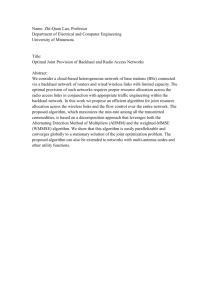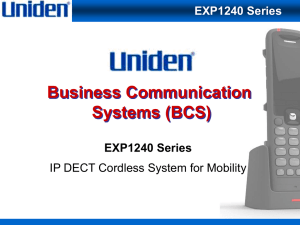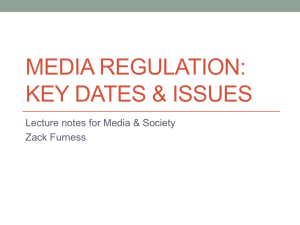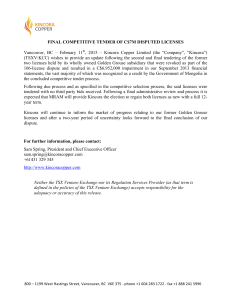The Mobile Network Infrastructure
advertisement
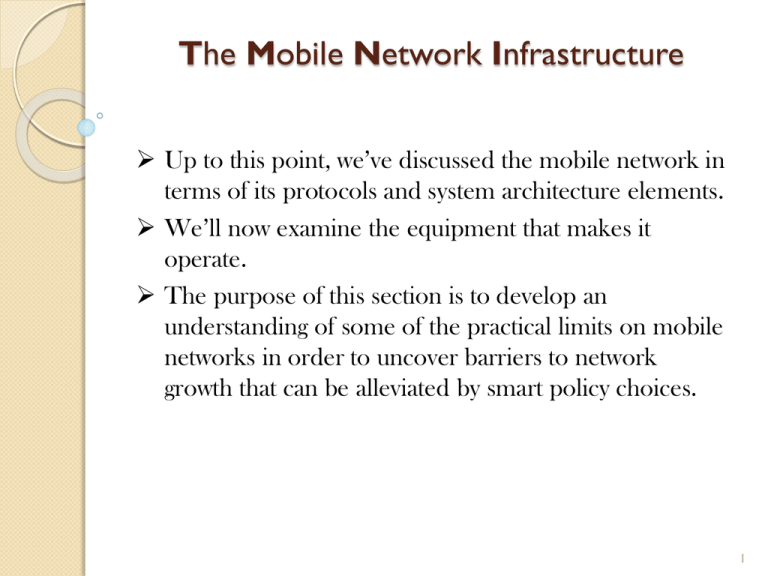
The Mobile Network Infrastructure Up to this point, we’ve discussed the mobile network in terms of its protocols and system architecture elements. We’ll now examine the equipment that makes it operate. The purpose of this section is to develop an understanding of some of the practical limits on mobile networks in order to uncover barriers to network growth that can be alleviated by smart policy choices. 1 The Mobile Network Infrastructure Essential Parts of the Mobile Network The mobile network consists of three basic parts: A battery-powered mobile handset with one or more radios, each with its own antenna. A base station with one or more radios, each with its own antenna, that communicates with all the mobile handsets joined to its network in an area ranging from a city block to a few miles and bounded by the areas served by neighboring base stations. 2 The Mobile Network Infrastructure Essential Parts of the Mobile Network A backhaul system that connects base stations with the telephone network and then to the Internet. These 3 systems share characteristics that allow them to work as a common whole. 3 The Mobile Network Infrastructure The Handset Identifies the subscriber. Communicates his/her location (among other things.) Unique to mobile networks. 4 The Mobile Network Infrastructure The Handset Handsets turn their radios on and off several times a second at precise intervals to sense signals from the base station without consuming the power required for always-on operation. Handsets create the illusion of an always-on connection without actually having one. 5 The Mobile Network Infrastructure The Handset Handsets that are out of range don’t cycle. 6 The Mobile Network Infrastructure Base Stations Originally built to use a single radio and antenna. Redesigned to employ a technique known as sectorization that divides the coverage area into three or more sectors (imagine a pizza cut into three equal slices.) The load each cell tower can handle is directly proportional to the number of sectors. 7 The Mobile Network Infrastructure Base Stations Towers can be disguised. 8 The Mobile Network Infrastructure Base Stations Each sector is served by its own radio and antenna pair. Sectorization is a technique that increases the effective capacity of a base station. Every sectorization system creates areas of coverage overlap where signals from adjacent sectors overlap each other. Handsets are engineered to deal with these situations. 9 The Mobile Network Infrastructure Back Haul System of copper wire, fiber optic cable, microwave, or millimeter wave radio that connects base stations to the network operator’s wired network. Backhaul is a particularly serious deployment problem that often does get overlooked in the policy discussions around next-generation mobile networks because it’s seen as secondary to spectrum. 10 The Mobile Network Infrastructure Spectrum It’s the means by which handsets communicate with base stations. One very common means of providing backhaul. The frequencies for handset coverage are lower than those used for backhaul. Lower radio frequencies naturally tend to propagate more uniformly. Higher radio frequencies tend to propagate more narrowly. 11 The Mobile Network Infrastructure Spectrum Licensing considerations sometimes motivate network operators to use frequencies for particular applications that may be less than ideal, or to use them in novel ways. For example, an experimental network is building out in Claudville,Virginia using Wi-Fi for the last hundred feet and license-exempt 700 MHz White Spaces for backhaul. 12 Policy Recommendations Stick With Light Touch Regulations Heavy-handed regulation is ultimately bad for investment, deployment, and adoption of wireline networks, and potentially fatal to mobile networks. A key way to ensure that networks serve the public interest is through market mechanisms based on meaningful competition. 13 Policy Recommendations Enact a Sensible Transparency Rule The challenge for a transparency rule is to disclose the things that must be disclosed in order for users to gauge the experience they’ll have on any given part of the Internet ecosystem in terms the average person can understand, while making additional information available to the audience of technologists and policy analysts. 14 Policy Recommendations Legitimize Enhanced Transport Services There is widespread agreement among filers in the FCC’s Open Internet NPRM that differentiated services for differentiated fees are legitimate in their own right, and not simply as an adjunct to network management. If ISPs who operate “eyeball networks” are permitted to compete with CDNs and Overlays, new entrants can expect lower prices and more competition, and end users should expect a wider array of options. 15 Policy Recommendations Define Reasonable Network Management The transparency rule, and its specific implementation, provides insight into the boundaries of reasonable network management practices. While the use of the term “reasonable” without definition is impossibly vague, anchoring management practices to service disclosure resolves a great deal of the mystery. This also has to do with conforming to standards. 16 Policy Recommendations Preserve Engineering and Operations Freedom The primary emphasis of the Open Internet NPRM’s framework of rules is on the preservation of users’ freedom to experience the Internet as they see fit, without arbitrary limitations. A key way to preserve this freedom is to address the dynamics of technical freedom that make it possible. Toward that end, the NPRM should make it clear nothing in the FCC’s approach denies the freedom to invent, develop, and adopt new networking technologies, business models, and practices that have the potential to enhance the Internet’s power, efficiency, vitality, or effectiveness. 17 Policy Recommendations Review Existing Spectrum Licenses The FCC needs to complete its inventory of the licenses it has issued over the years, and implement a system that eliminates or reduces ambiguity about licenses going forward. If it’s true that the FCC has somehow lost track of some licenses, as some have suggested, this error should be corrected. It’s simply not acceptable for the national regulator of wireless networks to lose track of issued licenses. 18 Policy Recommendations Eliminate Redundant and Archaic Licenses Once the license inventory is complete, it will be possible to examine licenses to determine which are unused, which are redundant, and which can be combined with others to free up spectrum for auction or other kinds of assignment. The general principle that should hold in the process of review is modernization, replacing archaic analog applications with more spectrum-efficient digital ones. 19 Policy Recommendations Protect Spectrum Subleasing These kinds of secondary markets are also useful in the microwave backhaul and point-to-point space where a given license holder can adjust microwave paths with relays and dogleg arrangements to accommodate most effective use. 20 Policy Recommendations Cautiously Enable Secondary Uses The principle use of secondary services should be in areas where the primary user is not active; this is the logic behind the Dynamic Frequency Selection (DFS) system in IEEE 802.11a Wi-Fi. This system requires Wi-Fi systems to look for the use of radar on certain channels, and to refrain from using channels where radar is found. 21 Policy Recommendations Allow the Experiment to Continue The way forward is a careful, diligent, step-by-step process beginning with reviews of historical rules and precedents and ending in the creation of a new framework that will enable the next generation of networking to flourish. The evidence of an emerging consensus among responsible parties in the U. S. and Europe suggests it’s well underway. 22
